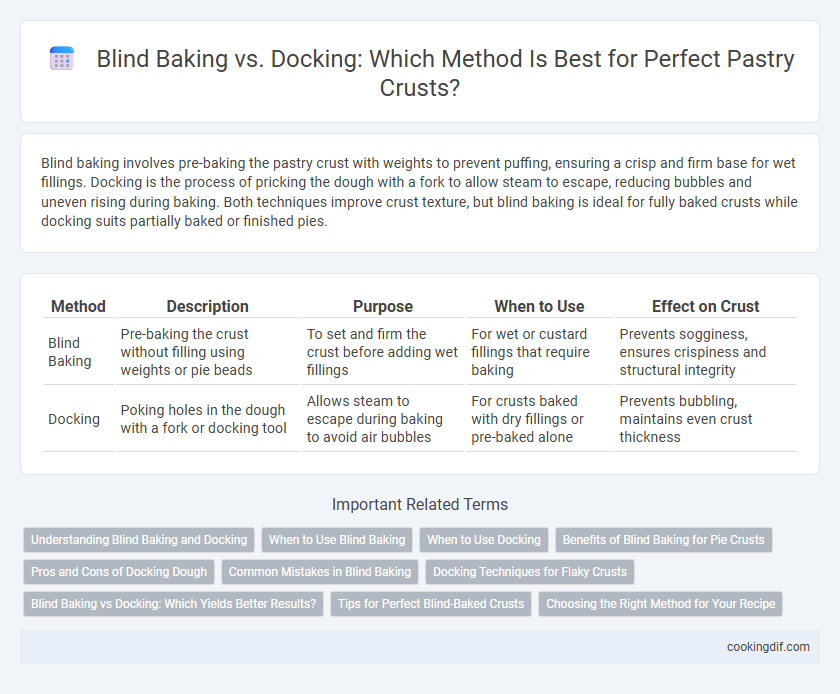Blind baking involves pre-baking the pastry crust with weights to prevent puffing, ensuring a crisp and firm base for wet fillings. Docking is the process of pricking the dough with a fork to allow steam to escape, reducing bubbles and uneven rising during baking. Both techniques improve crust texture, but blind baking is ideal for fully baked crusts while docking suits partially baked or finished pies.
Table of Comparison
| Method | Description | Purpose | When to Use | Effect on Crust |
|---|---|---|---|---|
| Blind Baking | Pre-baking the crust without filling using weights or pie beads | To set and firm the crust before adding wet fillings | For wet or custard fillings that require baking | Prevents sogginess, ensures crispiness and structural integrity |
| Docking | Poking holes in the dough with a fork or docking tool | Allows steam to escape during baking to avoid air bubbles | For crusts baked with dry fillings or pre-baked alone | Prevents bubbling, maintains even crust thickness |
Understanding Blind Baking and Docking
Blind baking involves pre-baking the pastry crust without filling to ensure it sets and remains crisp when filled later, preventing sogginess in recipes like custard tarts. Docking refers to the technique of piercing the dough with a fork before baking to allow steam to escape, preventing the crust from puffing up unevenly. Both methods are essential for achieving a perfectly textured crust, with blind baking often requiring weights and docking primarily used for lighter pies and pastries.
When to Use Blind Baking
Blind baking is essential when preparing pie crusts or tarts with wet fillings that require longer baking times, such as custards or fruit fillings, to prevent soggy bottoms. It ensures the crust is fully cooked and crisp before adding the filling, especially important for recipes with no further baking or short baking after filling. Docking, which involves pricking the dough to allow steam to escape, is suitable for recipes with shorter baking times but does not replace blind baking when a fully crisp crust is needed.
When to Use Docking
Docking is essential for pie crusts and tart shells with a wet filling, such as custards or quiches, to allow steam to escape and prevent bubbling during baking. Use docking when a recipe calls for a single bake or partial bake before adding the filling, as it maintains a flat surface without the need for weights. This technique is ideal for recipes that do not require a fully blind-baked crust, minimizing risk of over-baking or shrinkage while ensuring even cooking.
Benefits of Blind Baking for Pie Crusts
Blind baking enhances pie crusts by creating a firm, fully cooked base that prevents sogginess from wet fillings. Using pie weights during blind baking maintains the crust's shape, ensuring even baking and a crisp texture. This technique is especially beneficial for custard or cream pies, where the filling doesn't require baking time.
Pros and Cons of Docking Dough
Docking dough involves piercing the pastry crust with a fork to create small holes, preventing air bubbles and uneven rising during baking. This technique allows steam to escape, resulting in a flatter, more uniform crust ideal for pies and tarts with wet fillings. However, docking can sometimes lead to slight over-browning around the holes and may not fully prevent puffing in extremely high-hydration doughs.
Common Mistakes in Blind Baking
Common mistakes in blind baking include failing to properly weigh down the crust, which causes puffing and uneven cooking, and neglecting to prick the dough before baking, leading to air bubbles and an irregular surface. Using insufficient baking weights or skipping the docking process can result in a soggy or misshapen crust. Proper blind baking requires accurate dock placement and consistent weight distribution to ensure a crisp, evenly baked pastry base.
Docking Techniques for Flaky Crusts
Docking techniques for flaky crusts involve piercing the dough with a fork or specialized tool to create small holes that allow steam to escape during baking, preventing unwanted puffing and ensuring an even, crisp texture. This method is essential for maintaining the delicate layers of a flaky pastry by controlling moisture buildup and promoting uniform heat distribution. Proper docking complements the structural integrity of the crust, resulting in a tender yet sturdy base ideal for custard or fruit fillings.
Blind Baking vs Docking: Which Yields Better Results?
Blind baking involves pre-baking the pastry crust without filling to ensure a crisp, fully cooked base, while docking consists of pricking the dough to prevent puffing during baking. Blind baking yields better results for recipes requiring a fully set crust prior to adding wet fillings, as it creates a sturdy, golden foundation with minimal shrinkage. Docking is more suitable for flaky crusts where slight puffing is desired, but it may result in a slightly less crisp pastry compared to blind baking.
Tips for Perfect Blind-Baked Crusts
Use blind baking to prevent soggy pastry crusts by lining the dough with parchment paper and filling it with pie weights or dried beans for even baking. Docking, which involves pricking holes in the dough with a fork, helps release steam and prevent air bubbles in thinner crusts. For perfect results, combine light docking with blind baking to ensure a crisp, evenly cooked base ideal for all types of pies and tarts.
Choosing the Right Method for Your Recipe
Blind baking involves pre-baking the crust using pie weights or beans to prevent puffing, ideal for custard or cream pies requiring a fully cooked base. Docking, the technique of piercing the dough with a fork, helps steam escape and reduces bubbling, best suited for pies baked with fillings that require partial cooking or no pre-baking. Selecting the right method depends on the filling type and baking time to achieve a crisp, even crust without sogginess or warping.
Blind baking vs Docking for crust preparation Infographic

 cookingdif.com
cookingdif.com